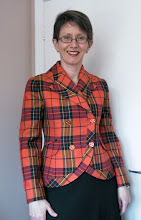I quickly assembled the jacket fronts and backs, and then paused since I'm planning to make three bound buttonholes. One has to fortify oneself for bound buttonholes, although I'm confident that in this fabric, I could make many mistakes and no one would ever notice.
In the meantime I decided to test out the piping on the skirt. This caused me to stop and ponder sewing order. Burda instructs sewing the lower front skirt (with pockets) first, then the lower back (which has no CB seam). The right side seam is sewn. Then the waistband is constructed, except for the left side seam (which has the zipper). The entire waistband is then sewn in one pass, and the left side seam with zipper is constructed last.
Phooey to that I say! First, I find it easier to insert the zipper in the relatively straight CB so I made a seam there. This also allows me to make a back vent, for walking ease.
A brief word on fitting: This pattern is meant for quite stretchy cotton/lycra twill and as designed it has almost no ease. All the PR reviews showed it was very tight. Based on flat pattern measurement, I added a 1cm strip down the CF and CB (4cm or 1.5"). This gives about the right amount of ease. Then all I had to do was fine tune the shape of the side seams.
 Back to construction. I like to put in the zipper flat, then sew the side seams last. This allows me to do fine changes to improve the fit as I sew. Normally I would make the front starting with the pockets, then apply the waistband in one pass, as illustrated in green at right.
Back to construction. I like to put in the zipper flat, then sew the side seams last. This allows me to do fine changes to improve the fit as I sew. Normally I would make the front starting with the pockets, then apply the waistband in one pass, as illustrated in green at right.  However, I'm piping the seams shown in pink at left. I wanted a continuous line of piping which would be impossible if I sewed the waistband seam last.
However, I'm piping the seams shown in pink at left. I wanted a continuous line of piping which would be impossible if I sewed the waistband seam last. So I changed the sewing order. It isn't all that hard.
First I sewed the CB waistband to the lower skirt front (the curved waistband seam between the lines of piping). Then I piped the edges in a continuous line.
Then I attached the pocket facing piece, but stopped sewing at the waistband seam.
Next, I attached the side waistband at the piped seam, again stopping sewing at the waistband seam. Ideally there is no more than a tiny gap between the two.
Finally, I attached the side piece, which forms the back of the pocket. I sewed the top seam first, again stopping at that point (or as close as I could get to it) where all the seams meet. After that it was an easy task to sew the pocket bag.
The last step was to anchor the waistband seam through all layers by stitching in the ditch (did I say this fabric is very forgiving?) for a centimetre or so. It's invisible.
For piping and the pocket facings, I'm using left over black wool fabric from these pants. I'll do the bound buttonholes in this too, as narrow and unobtrusive as I can make them. Later.








So glad you are adding this subtle and lovely piping. It accents the skirt and your waist without overwhelming the design and flattering lines.
ReplyDeleteThe piping adds that extra bit of luxury and class. Hopefully the jacket will work well with the pants as well.
ReplyDeleteI love both the fabric and how you added the piping to it. It's going to be an amazing skirt!
ReplyDeleteWow, it is turning out beautifully! Can't wait to see the completed suit. I too prefer my fitted skirts with zippers at the back and a kick pleat. But on dresses I move the zipper to the side seam if I can.
ReplyDeleteI love the piping detail! And yes, fortification is important before tackling bound buttonholes!
ReplyDeletemi piace questa gonna e tu sei bravissima complimenti un bacio lili
ReplyDeleteLove the piping idea. Thanks for showing how you're fitting it into the construction process.
ReplyDeleteI love piping - it just gives the garment that extra pop of "finish".
ReplyDeleteKay, yet another elegant garment with wonderful fabrics! I've been lurking for some time on sewing blogs and at artisan square, as I slowly get back into garment sewing after a very long absence. I live in Alberta, near Edmonton , where we are reduced to one fabric shop [other than Fabricland and Marshalls, which is similar]; but I will be in Montreal and then Ottawa for a few days in mid-April, andI wondered if you could provide some clues about where I could get some badly-needed fabric shop retail therapy.
ReplyDeleteCarol
I would head straight to the Jean Talon metro stop in Montreal, walk to St. Hubert Street, and head north. In the next few blocks there are quite a few great shops. My favorites are Couture Elle, Sam's, and Tissus Tuéni.
DeleteIn Ottawa, there's not a huge selection. Darrell Thomas has nice fabric but the prices are higher than in Montreal.
DeleteKayY, thank you for your help. A friend and I spent a morning on St. Hubert, and despite the snow/sleet/rain/wind and cold, had a fantastic time! Saw too many possibilities and choices, found a few great pieces of fabric, meet some really interesting folk,and had a lovely reunion at the same time.
ReplyDeleteIn Ottawa, I did make it to Darrel Thomas, where I had a fun visit with him - not, perhaps, the bargains possible in Montreal but very nice fabrics.
Your suggetions were so helpful, and I'll think of you as well as this trip when I sew these fabrics.
Carol
Elegant, figure flattering and stylish.
ReplyDeleteThe piping is a subtle detail.